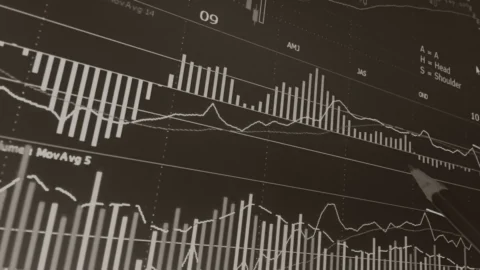RGWM Market Thoughts – October 4, 2019
The end of September saw the S&P 500 grow 1.87% for the month which pushed the market past the losses from July and August to end the quarter up 1.18%. At a 19.94% return YTD, the S&P 500 ended the third quarter close to only 2% off its all-time high. The start of the 4th quarter has seen a sharp reversal, with the market dropping over 3% in two days bringing it to its lowest levels since August. The reassurance we received from the Fed in September has now been sidelined in favor of a focus on the continuing China trade disputes, an impeachment inquiry that is becoming a reality, and instances of weaker than expected economic data.
Drawing back to a theme we’ve emphasized in previous market newsletters, it is important to separate the substantial from the flashy with respect to the headlines. The news stories that will attract the most attention from viewers will obviously be in the political theater that has consumed the media zeitgeist. The seemingly mundane news often provides the most data and the most impact to financial markets. Tuesday saw the release of the ISM Manufacturing Index, a gauge of US manufacturing that showed the lowest reading in over a decade. The 47.8% reading for September was the lowest since June 2009 and was the second consecutive month of contraction; defined by a 41% reading in new export orders, the lowest since March 2009. Readings below 50% in the index signal contractions. The manufacturing index is a leading economic indicator for the economy and only exacerbated investor fears of a global economic slowdown. It is the latest evidence that the US China trade war has negatively impacted the economy, most notably the manufacturing sector.
Another negative piece of data was released Wednesday as the ADP Research Institute showed payrolls at U.S. companies increased at a rate below forecasts in September. Private payroll increased by 135,000, the smallest advance in three months and less than the 140,000 projected by median economists’ forecasts. The August data was revised downward from 195,000 to 157,000, a figure that culminated with the previously mentioned ISM report paints a gloomy picture of the manufacturing economy. While conventional wisdom has one think that layoffs are the clearest sign of recession danger, data points to recessions starting due to companies refusing to hire people. While that has not happened so far, hiring is slowing down and could be starting to peak which is something we will be watching closely.
While the data outlined above has sounded alarms and scared some investors, we still see a recession in the short term as the less likely outcome. The health of the cyclical sectors within the economy have not shown signs of a concerning boom or bust yet; residential investment, business fixed investment, and changes in private inventories have not shown the typical upward or downward spikes as a percentage of GDP that you’d typically see preceding or during a recession. Inflation remains at a level close to the Federal Reserve’s mandate and unemployment itself remains at a remarkably low level. As we’ve mentioned in the past, the level of economic growth we saw in 2018 was well beyond the norm of what we should expect. Fiscal stimulus in the form of tax cuts boosted consumer spending and allowed corporations to operate more profitably and conduct buybacks that have helped boost equity valuations. While GDP has slowed, we still expect the economy to grow at slightly below 2% and to avoid a recession in the next year.
As mentioned in our mid-June newsletter, we lowered the overall equity risk of our portfolios as part of our previous rebalance. The primary adjustment included trimming some of the overall equity exposure within our portfolio in favor of adding to fixed income and liquid alternatives. Within equities we lowered our weightings in small cap equities, international equities, and emerging markets to upgrade our weightings within large cap US stocks which tend to bring more stability during global volatility relative to the former. On the fixed income side, we increased our exposure to higher quality and longer maturity bonds. These trades were made to lower the overall risk profiles among our portfolios and to counter against potential volatility in equity markets.
Now for the flashier headlines, a controversial conversation between President Donald Trump and the President of Ukraine has led to an impeachment inquiry being held by the Democrat controlled House of Representatives. While the calls for impeachment are dramatic, the facts facing the House is that a Republican controlled Senate is extremely unlikely to move forward in removing the President from office even if Democrats are united in their efforts of impeaching the President. While the President’s approval rating in the country overall continues to oscillate in the mid 40 percentile range, his popularity within the Republican party remains strong at a range polling in the mid to high 80s. The point being that unless evidence brings out something unavoidably incriminating, entertaining any sort of efforts of impeachment will be extremely politically damaging to the Republican Senate within its own party. In addition to the unlikelihood of an Impeachment Hearing bearing a conviction, some Representatives within the Democratic Party only see the calls for Impeachment as a distraction. As it was with “Russiagate”, barring a smoking gun, realistic momentum towards impeachment from this inquiry seems unlikely and if it does occur the President is very unlikely to be ousted.
While impeachment is unlikely, the prospects for how this influences the election in 2020 are much foggier. History showed that the Impeachment Hearing for President Bill Clinton proved to be an unpopular political move by the Republican House that may have even bolstered the support of the Democratic base heading into his reelection. There’s also the topic of the phone call between the President and the Ukrainian leader itself; President Trump’s apparent attempt to coerce the Ukrainian leader into investigating Former Vice President Joe Biden’s son’s business dealings with Ukrainian businesses. Senator Elizabeth Warren is now the odds market favorite in the Democratic Primary and the continued spotlight on Biden during the Impeachment Inquiry of President Trump could continue to damage Biden’s support and aid Warren. Senator Bernie Sander’s health concerns could also play a factor in Warren’s campaign given the overlap in their base. An Elizabeth Warren general election campaign would bring even more uncertainty into markets given the drastic policy differences she would bring as President relative to the status quo. Her positions on heightened financial regulations and corporate taxes would likely be damaging to equity valuations in the short run.
Considering the recent volatility, we want to take some time to go over our current positioning and the risk structure that defines our TAAP Portfolios. From a positioning standpoint, our portfolios place a heavy emphasis on the need to maintain a diverse portfolio of asset classes throughout the entirety of the business cycle. We view domestic and international equities, fixed income, and liquid alternatives as all being important components within our portfolios, with the short-term weightings we employ during rebalances being the adjustments to navigate through the various ebbs and flows within the business cycle. The long run proportions of those weightings within each asset class have always been dictated by our clients’ risk tolerances and the longer-term objectives of each portfolio. The varying levels of correlation and noncorrelation between equities, fixed income, and liquid alternatives allows us to minimize portfolio volatility while growing the overall portfolio according to client-defined objectives and risk tolerance.
In selecting the investment managers who represent each of these asset classes in our model portfolios, we place a high level of focus on managers that demonstrate a balanced track record of optimizing their risk to return tradeoffs. Some of these important risk-return attributes include tighter standard deviation and a lower level of downside risk relative to return. Managers with these characteristics tend to outperform their riskier competitors in volatile market environments. By combining this risk minimizing investment selection methodology with the asset allocation process described in the previous paragraph we can further prepare our model portfolios for the moments of volatility that we’ve seen this week.
Need Some Help?
If you’d like some help from one of our CPAs or CERTIFIED FINANCIAL PLANNER (CFP®) advisors regarding this strategy and how it applies to you, the Rhame & Gorrell Wealth Management team is here to help.
Our experienced Wealth Managers facilitate our entire suite of services including financial planning, investment management, tax optimization, estate planning, and more to our valued clients.
Feel free to contact us at (832) 789-1100, [email protected], or click the button below to schedule your complimentary consultation today.
IMPORTANT DISCLOSURES:
Corporate benefits may change at any point in time. Be sure to consult with human resources and review Summary Plan Description(s) before implementing any strategy discussed herein.Rhame & Gorrell Wealth Management, LLC (“RGWM”) is an SEC registered investment adviser with its principal place of business in the State of Texas. Registration as an investment adviser is not an endorsement by securities regulators and does not imply that RGWM has attained a certain level of skill, training, or ability. This material has been prepared for informational purposes only, and is not intended to provide, and should not be relied on for, tax, legal or accounting advice. You should consult your own CPA or tax professional before engaging in any transaction. The effectiveness of any of the strategies described will depend on your individual situation and should not be construed as personalized investment advice. Past performance may not be indicative of future results and does not guarantee future positive returns.
For additional information about RGWM, including fees and services, send for our Firm Disclosure Brochures as set forth on Form ADV Part 2A and Part 3 by contacting the Firm directly. You can also access our Firm Brochures at www.adviserinfo.sec.gov. Please read the disclosure brochures carefully before you invest or send money.













